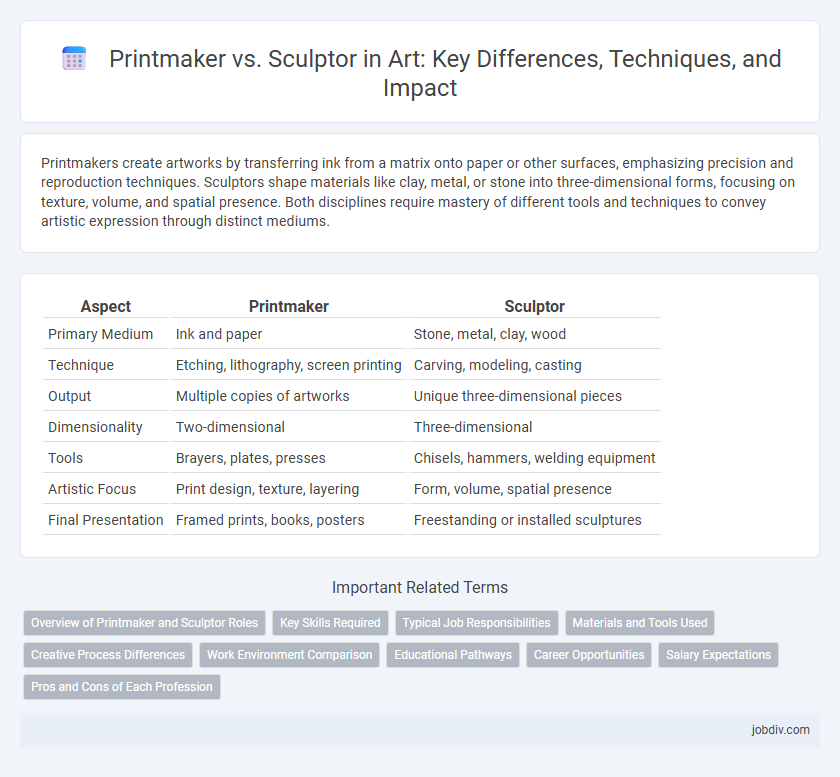Printmakers create artworks by transferring ink from a matrix onto paper or other surfaces, emphasizing precision and reproduction techniques. Sculptors shape materials like clay, metal, or stone into three-dimensional forms, focusing on texture, volume, and spatial presence. Both disciplines require mastery of different tools and techniques to convey artistic expression through distinct mediums.
Table of Comparison
| Aspect | Printmaker | Sculptor |
|---|---|---|
| Primary Medium | Ink and paper | Stone, metal, clay, wood |
| Technique | Etching, lithography, screen printing | Carving, modeling, casting |
| Output | Multiple copies of artworks | Unique three-dimensional pieces |
| Dimensionality | Two-dimensional | Three-dimensional |
| Tools | Brayers, plates, presses | Chisels, hammers, welding equipment |
| Artistic Focus | Print design, texture, layering | Form, volume, spatial presence |
| Final Presentation | Framed prints, books, posters | Freestanding or installed sculptures |
Overview of Printmaker and Sculptor Roles
Printmakers employ techniques such as etching, lithography, and screen printing to create multiple copies of artwork on paper or other surfaces, emphasizing precision and reproducibility. Sculptors manipulate materials like clay, stone, metal, or wood to form three-dimensional art, focusing on mass, volume, and spatial presence. Both roles require a deep understanding of artistic form and materials, but printmakers specialize in two-dimensional replicable works while sculptors concentrate on unique three-dimensional creations.
Key Skills Required
Printmakers excel in precision, attention to detail, and mastery of various printing techniques such as etching, lithography, and screen printing, requiring a steady hand and keen eye for textures and layers. Sculptors demonstrate strong spatial awareness, manual dexterity, and proficiency with diverse materials like clay, stone, and metal, along with skills in carving, molding, and assembling three-dimensional forms. Both disciplines demand creativity and technical expertise, but printmakers focus on two-dimensional design execution, while sculptors engage in creating tangible, volumetric art pieces.
Typical Job Responsibilities
Printmakers primarily focus on creating artworks through techniques such as etching, lithography, and screen printing, requiring precise ink application and plate preparation. Sculptors are involved in shaping materials like clay, metal, or stone to create three-dimensional forms, often using tools such as chisels, hammers, and welding equipment. Both artists must conceptualize original designs and frequently collaborate with galleries or clients to produce commissioned pieces.
Materials and Tools Used
Printmakers primarily use materials such as wood, metal plates, and linoleum, employing tools like carving knives, etching needles, and printing presses to create detailed two-dimensional images. Sculptors work with a variety of materials including clay, stone, metal, and wood, utilizing tools such as chisels, hammers, welding equipment, and modeling tools to shape three-dimensional forms. The distinct selection of materials and tools directly influences the artistic techniques and final aesthetic qualities in printmaking versus sculpture.
Creative Process Differences
Printmakers engage in a meticulous process involving the creation of plates, screens, or blocks to transfer ink onto surfaces, emphasizing replication and precision in each print. Sculptors manipulate materials such as clay, metal, or stone through carving, modeling, or assembling, prioritizing the physical transformation of three-dimensional forms. While printmaking centers on reproducibility and surface detail, sculpture focuses on volume, texture, and spatial presence to convey artistic expression.
Work Environment Comparison
Printmakers typically work in well-ventilated studios equipped with printing presses, inks, and specialized paper, prioritizing controlled environments to manage chemicals and moisture. Sculptors often require larger, more rugged workspaces such as workshops or outdoor studios to accommodate heavy tools, materials like stone or metal, and dust or debris. Both disciplines demand safety measures but differ significantly in spatial scale, equipment complexity, and material handling within their creative environments.
Educational Pathways
Printmakers typically pursue specialized training in printmaking techniques such as etching, lithography, and screen printing through fine arts programs or dedicated workshops, often earning a Bachelor of Fine Arts (BFA) with a concentration in printmaking. Sculptors generally follow educational pathways emphasizing three-dimensional art, including courses in ceramics, metalworking, and digital modeling, commonly obtaining a BFA or Master of Fine Arts (MFA) with a focus on sculpture. Both disciplines require hands-on studio practice and art history knowledge, but printmaking often involves more technical print processes while sculpture emphasizes spatial design and material manipulation.
Career Opportunities
Printmakers often find diverse career opportunities in graphic design, illustration, and fine art publishing, benefiting from digital and traditional print techniques. Sculptors typically pursue careers in public art commissions, gallery exhibitions, and restoration projects, leveraging their expertise in materials like stone, metal, and clay. Both fields offer potential roles in education, but printmaking tends to have broader applications in commercial industries.
Salary Expectations
Printmakers typically earn an average salary ranging from $40,000 to $60,000 annually, influenced by factors such as experience, location, and gallery representation. Sculptors' salaries tend to be more variable, often ranging from $30,000 to $70,000 per year, with top earners benefiting from commissioned public works and private collections. Both fields offer potential for higher income through art sales, exhibitions, and teaching opportunities, but sculptors generally encounter greater fluctuations in earnings due to material costs and project scale.
Pros and Cons of Each Profession
Printmakers excel in creating multiples of detailed, reproducible artworks using techniques like etching and lithography, offering greater accessibility and affordability to art collectors; however, the process can be time-consuming and requires meticulous attention to detail. Sculptors work with three-dimensional materials such as clay, metal, or stone to produce unique, tactile pieces that engage viewers spatially, but their work demands significant physical labor and studio space, limiting mass production. Printmaking provides versatility and wider distribution, whereas sculpting offers originality and material presence, making the choice dependent on artistic goals and resource availability.
Printmaker vs Sculptor Infographic

 jobdiv.com
jobdiv.com